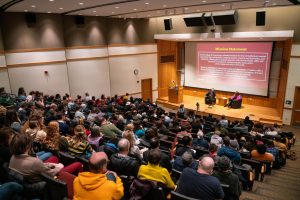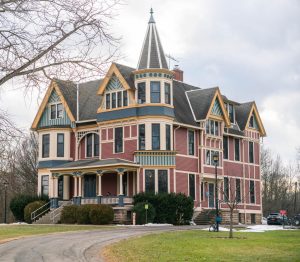On the Record with Conductor Raphael Jiménez and Composer Ricardo Lorenz
October 3, 2014
Raphael Jiménez conducted the Oberlin Orchestra for the world premiere of composer Ricardo Lorenz’s “Olokun’s Awakening” in the Orchestra’s first concert of the semester last Saturday. The composer arrived on campus several days before the premiere to collaborate with Jiménez and coach the Orchestra in its final rehearsals. The Review spoke with both musicians about their collaborative history and the creative process behind “Olokun’s Awakening.”
How did you two get your start in music?
Ricardo Lorenz: I started in a rock band in Caracas, in Venezuela where I’m from. It was a sort of fusion rock band with a bunch of friends. Eventually all of us ended up in conservatory there.
Raphael Jiménez: I actually started in a conservatory in Caracas, and very soon I was recruited to join the El Sistema program.
Where did you first meet?
RJ: We met in Caracas where I was assistant conductor of the Caracas Sinfonietta and they were premiering a piece by Lorenz. That’s where we met, but we didn’t make contact again until later on when I was working at Michigan State University. I was running a Latin American music series, and I invited Ricardo to come visit. We performed one of his pieces, and he gave a lecture so good that the university recruited him and he ended up working at Michigan State University. We worked together for many years until I came to Oberlin.
How did this collaboration start?
RL: Raphael, who started as a ballet conductor, once commented that there are no Latin American ballets in the standard repertoire. So I decided to write one, and I came across this legend that originated in Cuba. Right away I thought that it must be made into an opera or a ballet, and that’s how it all got started. The story is really interesting because it combines typical human themes like jealousy and romance with some of the worst calamities of the 20th century like racism and fascism, so it’s just the perfect story. Since finding the story, I’ve collaborated with Raphael to make sure the story works well and then also to write a first scene to have something we can pitch for future sponsors for the larger plan.
How do you approach the score for a piece that is about to be performed for the first time?
RJ: It’s not different from any other piece. The first thing is to get a good idea of the general picture and what the piece looks like. I try to distance myself and have an eagle vision of the work as a whole, because, to me, the structure and the shape of a piece are essential. Once I know how to navigate the piece, I go deeper and try to understand all the parts that make up the structure of the piece.
The difference here is that I have a great relationship with Ricardo, and so we can talk about it. I can ask him exactly what he wants, and we can really collaborate on the piece. I try very hard to get close with new composers so we can have that sort of productive relationship. Sometimes it’s easy to do, and sometimes it’s more difficult, but the ultimate goal is to bring the piece alive, so it’s really no different from any other score.
When you’re writing a new piece, what influences your decisions and the music?
RL: First, it comes from my heritage. I come from a culture where rhythm is essential for our understanding of music, so we communicate through rhythm in many ways. For me though, that’s never enough, and I need to have some sort of extra-musical inspiration. There’s always a story in the news or something happening in the world that gives me a real reason to sit down for so long and write a piece of music.
RJ: I can name two pieces by Ricardo right away; one is called “El Muro” and it was right at a time where there was a lot of discussion about building a wall at the border of Mexico and the U.S. The other is “Perfiles Sospechosos,” which is about the time after 9/11 when many people were suspicious of anybody that looked like they were from the Middle East.
RL: Yes, so these are examples of pieces. I have to have something of substance that connects me in a human way to something as abstract as music.
How about the connection for this piece, “Olokun’s Awakening”?
RL: It has many dimensions, that’s what I think is so rich about it and why it has so much potential. There are many different versions, and it’s become a popular saying in Cuba, “be careful or you’ll die like Chacumbele” which means be careful or you’ll get yourself in trouble because of something you did. [“Olokun’s Awakening” is the preview of the larger work, The Tales of Chacumbele.] It’s a sort of philosophical warning about being careful of your own mistakes. We’re trying to funnel all these different aspects into one dramatic piece.
RJ: The saying is basically saying “be careful not to dig your own grave.”
RL: We don’t even know where the story came from. I’ve interviewed people on the streets in Cuba, and everyone has their own story about how Chacumbele died. What I realized by talking to all these people was that they almost reflect themselves into how Chacumbele might have died. This is fascinating to see, because it adds another psychological aspect to the story, and it shows just how many different directions the story can go.
On top of all this is the idea that he died because of destiny, but that isn’t good enough for drama. We need to know who caused all the tragedies that befall the characters, so we added mythology from the Afro-Cuban religion. We added the
idea that a deity [named Olokun] is concocting this whole thing just to fulfill a prophecy and so on. So now we have some mythology and a culprit, which makes it more interesting. So this first scene [the concert piece] is where we see to what extent Olokun is manipulating the main characters and we’re seeing this deity arise and show itself.
Where do you see this project and collaboration going?
RJ: Well, that would depend on the success of us pitching the project to possible sponsors and supporters. We hope that it ends as a ballet produced by a major company, but we’ll see. What’s important is that when you have such a fantastic idea, you have to just get it out there. So Ricardo is certainly going to continue to write the piece, whether it be in the form of a symphonic work but hopefully as a fully staged ballet.
RL: Exactly, it could end up that it’s just four symphonic scenes, just like you’re performing it today, but I really think it’s going to end up in a major ballet company. We have such a great story and a great collaboration, so there’s no reason why it can’t be pitched and supported by a major ballet company. Another possibility would be to turn it into an animated film, but the main goal is to have it choreographed and staged with a ballet company.
























